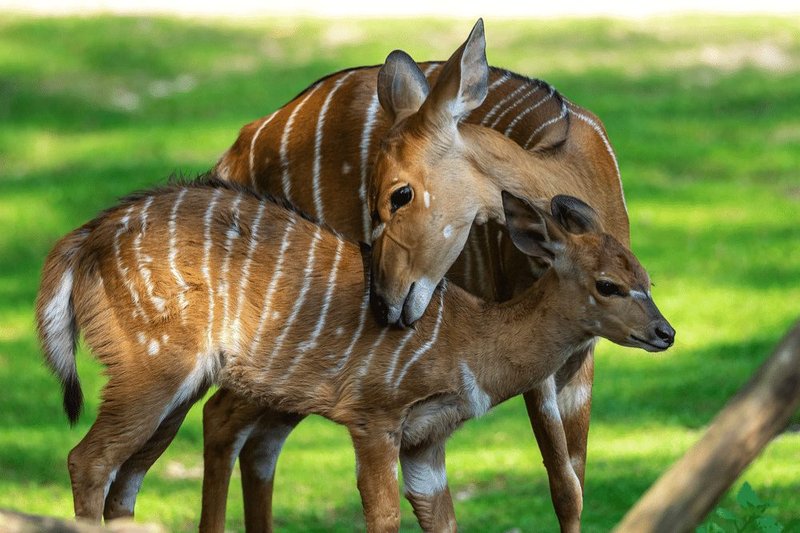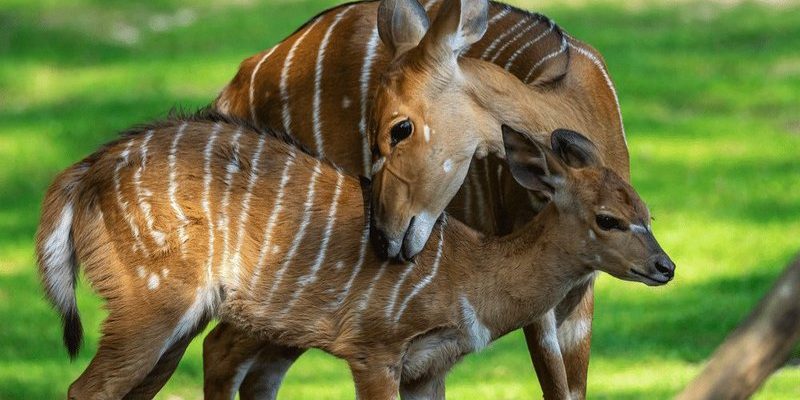
Nyalas are native to the bushy shrublands and woodlands of Southern Africa. With their long legs and spiral horns (at least in the males), they’re quite the sight to behold. But it’s not just their looks that are intriguing; it’s also their parenting skills. Watching a nyala mother interact with her fawns is like witnessing a tender dance choreographed by instinct. Here’s the thing: in the wild, rearing young ones is both a delicate art and a challenging feat.
The Role of Mothers in Nyalas’ Lives
In the nyala world, mothers are the primary caregivers, taking on the bulk of the responsibility when it comes to raising young fawns. After a gestation period of around seven months, a mother nyala gives birth to a single fawn, although twins can happen rarely. As soon as the fawn is born, the mother licks it clean, which is not just about hygiene—this act also helps strengthen their bond.
You might be wondering how a mother knows to keep her fawn hidden. Nyalas have a natural instinct to find secluded spots for their young. Often, they choose dense bushes or thick grass to keep their fawns safe from predators. For the first few weeks, the mother will leave her fawn concealed while she forages for food. This might seem harsh, but it’s a survival technique that many animals use—like a protective parent leaving a child in a safe space while they run errands.
Another crucial aspect of a mother’s role is her diet. While she’s nursing, a nyala mother will prioritize nutrient-rich foods. These include leaves, shoots, and fruits that give her the energy and nourishment needed to produce milk for her fawn. It’s like a new parent grabbing nutrient-packed snacks to keep up with a busy toddler!
Fawn Behavior and Development
Baby nyalas, or fawns, are born with a beautiful coat that features white stripes and spots, which help them blend into their surroundings. This camouflage is a lifesaver since predators are always lurking around. You might even say that nature is the best designer, crafting these patterns to keep the fawns safe.
During the first few weeks, fawns remain mostly inactive, relying on their mother for nourishment and protection. You may notice that when a mother returns to her fawn, she makes a soft call, allowing the little one to recognize her voice. This connection is essential, especially when the fawn starts to venture out.
As they grow, fawns begin to explore their environment more. They’ll practice walking, grazing, and even playing, which is vital for their development. Think of it as a toddler learning to walk—lots of wobbly steps and some playful tumbles! The playful interactions with their mother and surroundings help them build the skills they’ll need for survival later on.
Parental Cooperation Within the Herd
In nyala herds, it’s not just the mothers who help raise the youngsters. There’s a sense of community where other females often assist in caring for the fawns. This cooperation can be incredibly beneficial, especially when it comes to keeping an eye on the little ones while mothers are grazing or drinking.
Sometimes, you’ll see multiple mothers with their fawns gathering together. They’ll watch over each other’s young, like a little daycare in the wild. If a predator approaches, the adults team up to alert the herd, giving the fawns a better chance to find safety.
This cooperative behavior helps build stronger social bonds within the herd. When mothers share responsibilities, it nurtures a sense of trust and teamwork. Imagine a group of friends taking turns babysitting—it makes that demanding job a lot easier!
The Importance of Habitat for Raising Young
The environment where nyalas live plays a vital role in raising their young. They thrive in areas with plenty of cover, such as thick bushes and trees, which offer safety from predators. The lush landscapes of the bushveld provide not only shelter but also abundant food sources for both mothers and their fawns.
In these habitats, there’s also a balance of resources. Nyalas are browsers, which means they eat leaves, fruits, and other plant parts. This diet is essential for nursing mothers to sustain themselves and produce quality milk for their young. Plus, having enough food around makes the area less competitive. In turn, this means there’s a higher chance for the fawns to grow up strong and healthy.
But here’s the thing: habitat loss due to human activity is a critical issue. As land is cleared for agriculture or development, it impacts the availability of safe places for nyalas to raise their young. Keeping our environments healthy and balanced is key to ensuring future generations of these beautiful creatures can thrive.
Challenges of Raising Fawns in the Wild
Every mother faces challenges, and nyala mothers are no different. Predators like lions, hyenas, and leopards pose a significant threat to young fawns. A mother must be vigilant and quick to react to any signs of danger. Sometimes, this means making the tough choice to leave their fawn hidden while they draw predators away.
Drought and food scarcity can also be a challenge. When the environment is harsh, finding enough food becomes even more difficult for mothers who are trying to care for their young. In such times, they may have to migrate to find better resources, which can be stressful for the fawns, especially if they’re not yet accustomed to moving long distances.
That said, fawns have some tricks up their sleeves to help them survive these challenges. For instance, their ability to stay still and quiet when danger approaches is instinctive. This behavior can catch predators off guard, giving them a better chance at escaping.
The Journey to Independence
As time passes, the relationship between a nyala mother and her fawn naturally evolves. Around six months of age, the fawn starts to gain more independence. They’ll graze alongside their mother and even begin to venture out on their own. This gradual shift is essential; it prepares the fawn for life as a fully-fledged nyala.
You might notice that the mother still keeps a close eye on her young one, providing guidance and protection as needed. It’s like a parent watching their child learn to ride a bike—the goal is to give them the freedom to explore while staying ready to catch them if they fall.
Eventually, as the fawn matures, it will begin to separate from its mother to join a group of peers. This socializing is crucial for forging connections within the herd and learning important survival skills.
Conservation Efforts and the Future of Nyalas
With their unique ways of raising young, nyalas are truly special animals. However, their future is at risk due to habitat destruction and poaching. Conservation efforts are vital for ensuring they continue to thrive in the wild.
Organizations are working hard to protect natural habitats, promote responsible tourism, and raise awareness about the significance of preserving these animals. Supporting conservation can make a real difference. By being mindful of our actions and promoting wildlife preservation, we’re helping ensure that future generations of nyalas can raise their young and continue their legacy.
In a way, every small action contributes to the bigger picture. Just like a mother nyala carefully nurtures her fawn, we can all play a role in looking after our shared planet.
In conclusion, raising young nyalas in the wild is a journey filled with challenges, community cooperation, and instinctual behaviors. From the protective instincts of mothers to the rich environments they inhabit, there’s a lot to learn from these wonderful creatures. By understanding their world, we can appreciate the delicate balance of nature and take action to protect it for the future.

